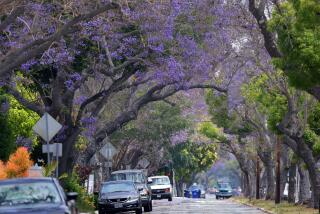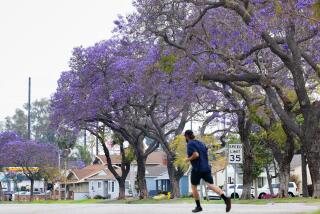Tips on Picking Out the Perfect Fruit Tree
If I could only grow two fruit trees, I would probably pick a lemon and a peach--the lemon because a good cook like my wife needs them almost daily and lemon trees oblige with a nearly constant crop; the peach because I can think of no other fruit that tastes so different when really ripe, which they never are in markets.
I’m sure that a peach was what the authors of Genesis had in mind when they were describing the forbidden fruit. A really ripe peach is so soft and juicy that you must eat it outside, or over the sink, and you have to wash your hands and face when you’re done. It is so sweet that even children don’t mind that it is covered with fuzz.
And while it is definitely not the time to plant lemons or any other citrus or subtropical fruit, it is the time to purchase and plant deciduous fruits like peaches--or apples, apricots, nectarines or plums--while they are bare root.
Satisfying Project
This is the only way to plant these fruit trees, and it is a very satisfying weekend project that easily fits into these too short mid-winter days.
Planting bare root trees is a snap--you simply spread out the roots in a large hole, and then fill it in. Just be careful to not bury the plant deeper than it was originally so the bulging bud union is well out of the ground. Pulverize the soil that goes back in the hole so it is not lumpy like sugar in a humid climate. Radical pruning is often suggested, but I simply cut all the branches back by half to compensate for the lost roots, and I don’t even think that is necessary.
You must also be careful not to get carried away by the bargain prices and buy too many fruit trees. Even those labeled “semi-dwarf” grow easily to 20 feet across, and just where are you going to put them all? And be careful to buy varieties that do well in Southern California since not all do.
Right outside my office at home is a perfect example of a peach that does well in Southern California. It is named Red Baron and it’s a “fruiting-flowering” peach. While all peaches put on quite a show when they flower, this one is a spectacle of bright magenta-pink flowers. It so dominates the garden when flowering in late March and early April that I have had to move some plants away from it because their own modest spring show went unnoticed. I might even choose a peach as one of my two trees simply for the flowers. And, there are peaches that only flower.
Planting Under It
Still another reason to choose a peach is that you can garden under it, so it really doesn’t take up as much space as, say, a lemon, which can’t be gardened under. Under a peach is a perfect place for many flowers and bulbs that can enjoy the soft winter sunshine, then slowly retreat into shade as the tree leafs out. Under this peach I grow Chinese ground orchids (Bletilla) --which are a story in themselves and also happen to be at nurseries this month--Japanese anemones, primroses, ajuga, daffodils and a big abutilon.
Looking out the door, I can also see that there are still a few leaves on the tree, despite the windy days and cold nights we’ve been experiencing. This wouldn’t happen in a colder climate and it shows how indefinite our winters are and points out the importance of buying a tree adapted to mild weather.
Peaches and other deciduous fruit trees including apples, apricots, nectarines and plums, are not completely at home in Southern California, preferring a little more cold than we can provide. They need the cold to trigger blossoming or to sprout leaves or, for that matter, to clue them in to when they should be dropping their leaves. This required chilling is called the “chill factor” and its necessity is a fact conspicuously missing from nursery labels--so you must do your own homework before deciding on a variety to plant.
In general, peaches and plums need the least amount of chilling. But even with these one must be wary, since some varieties are much more adapted to Southern California than others. Many nurseries--especially places that only sell plants as a sideline to hardware and lumber--unabashedly sell deciduous fruit trees that are very poor bets in Southern California. I have seen Elberta peach trees for sale, yet this peach was bred for cold, cold weather and bears poorly, if at all, in Southern California. I’m sure it’s a big seller in Spokane, but it shouldn’t even be tried in Southern California.
Check the Chill Variety
If you already have a peach that isn’t doing well, it is probably one of these high-chill varieties, because if you have low-chill variety, very little can go wrong until the tree is quite old (20 years or more).
Apples are even more finicky, and except for a very few hard-to-find varieties, pears and cherries are for much colder places.
So how do you make an intelligent selection? My advice is to wait and see what the nursery has and then wander over to the book section and look for Sunset’s “Western Garden Book,” or one of the Ortho or H. P. books on fruit trees. These list the multitudinous varieties--that would fill this entire View section--and they tell which do best where.
Looking out my office door, I can also see that it is about time to prune my peach, and to spray it, since there is one common peach ailment--peach leaf curl--that is sure to find my tree sooner or later. But pruning and spraying are two winter chores that can wait a week or two. Right now, it’s time to plant.
More to Read
Eat your way across L.A.
Get our weekly Tasting Notes newsletter for reviews, news and more.
You may occasionally receive promotional content from the Los Angeles Times.










